
No, no, no, I’m not talking about us clergy, although… well, never mind.
This article is about odd architectural and liturgical matters at the front of the church. Some you’ve seen and may have wondered about, but never thought to ask. Others perhaps you’ve never noticed, but now you will.
Just to confuse us, the word “Altar” is used in two different ways in the Orthodox Church. It may mean the Holy Table: The Divine Liturgy is celebrated “on” the Altar. But sometimes we use the word Altar to mean the whole area behind the Iconostasis: The Divine Liturgy is celebrated “in” the Altar. Which usage will I follow here? Probably both. “A foolish consistency is the hobgoblin of little minds…” Ralph Waldo Emerson
Since we’ll be talking about symbols here, let me tell you my approach to the subject. I think few if any ecclesiastical things were invented to be symbolic. I think they began for practical reasons, and then the symbolism was added later.
That’s the introduction. Here we go:
1 Why do Orthodox churches have Icon Screens, blocking off the view into the Altar from the congregation?
We’ll start with the symbolism, then go back to explain why the Iconostasis originally came to exist. This will take a little while.
For anyone coming from a Western background, the Icon Screen seems very odd indeed. Western liturgical denominations usually had an “Altar Rail” 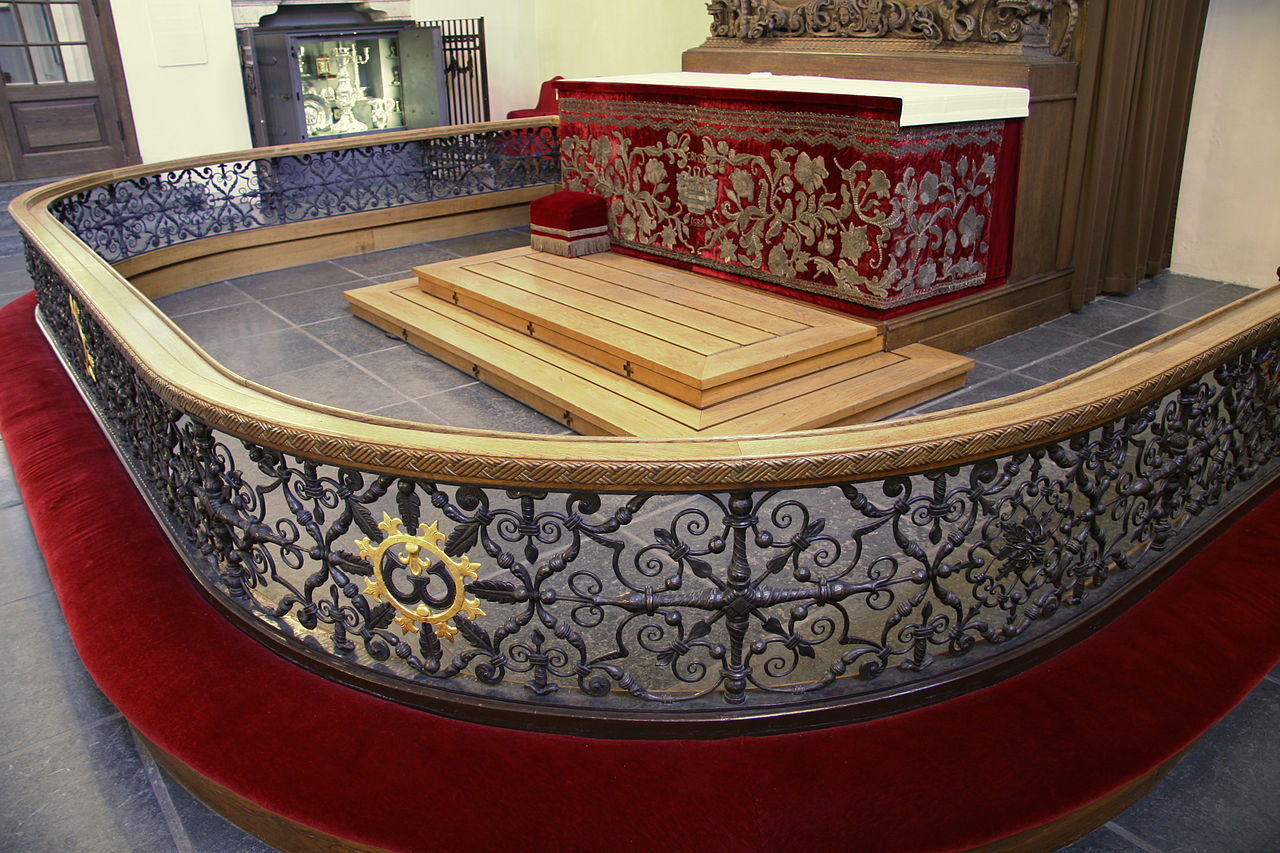 separating the Altar from the congregation, where people knelt to receive Holy Communion. In recent years even that has often been removed. Modern Western liturgical experts say this is partly a return to ancient Church practice, partly to symbolize that in Christ God has come into the world and is now totally accessible to all. True enough.
separating the Altar from the congregation, where people knelt to receive Holy Communion. In recent years even that has often been removed. Modern Western liturgical experts say this is partly a return to ancient Church practice, partly to symbolize that in Christ God has come into the world and is now totally accessible to all. True enough.
Above: Holmens-Kirche, Copenhagen – from Wikimedia
So is the Orthodox iconostasis intended to tell us that God and His love are inaccessible for us? No. Of course not.
The Orthodox church (sometimes called the “temple”) has over the centuries become a symbol of our journey and progress into the Kingdom of God.
We often approach the church through a hall where sometimes Old Testament saints are depicted. Then through the door into a narthex nearer the Kingdom, 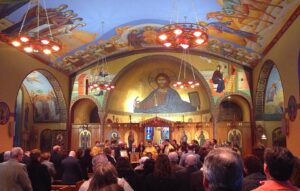 where we pray to God and light candles before icons. Next we pass through another entrance into the church proper. Sometimes the Baptismal Font is there, for that is where we begin our journey into the Kingdom. This is where we are now, worshiping God the Holy Trinity with His Holy People on earth and in Heaven, shown by their icons.
where we pray to God and light candles before icons. Next we pass through another entrance into the church proper. Sometimes the Baptismal Font is there, for that is where we begin our journey into the Kingdom. This is where we are now, worshiping God the Holy Trinity with His Holy People on earth and in Heaven, shown by their icons.
Above: St Sophia Greek Orthodox Church, New London CT
At the very front, to get to the subject, is the Iconostasis through which we do not go – except on “business” with a blessing, like the acolytes. Consistent symbolism would require that none of us should enter there, for this is where we are not, not yet – the Heavenly Altar, the Holy Place where the Great Banquet in the eternal Kingdom of God is celebrated, somewhat elevated and separated from the rest of the church by the Iconostasis..The clergy and acolytes go there only are practical reasons, to preside at and assist with the worship. Even the priest should not spend his time just “hanging around” there casually. 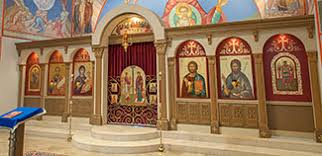
Above: St Joseph Church, Houston TX
In the center of the Iconostasis are the Royal Doors. The Little and Great Entrances carry us in spirit into the Kingdom, where we desire to be. Through these Royal Doors the priest, acting as Christ not as himself, brings Him out to us to proclaim His Words in the Holy Gospel, and then again to bring Christ for us to receive in the Holy Eucharist.
Though you and I are not yet there in the fullness of Christ’s Kingdom, on the Screen are icons – “windows into Heaven” – showing those who are there: Our Lord Jesus Christ, the Theotokos, John the Forerunner (“greatest among those born of women” Matthew 11:11, Luke 7:28.), the patron saint who looks after that community – and then icons of angels and of other saints.
That’s how the Iconostasis is intended to function. Think of it that way, and you will not feel it cuts you off from the Altar, rather that it calls you in. Persevere! Come up higher!
Were Orthodox churches always like this? No. Anciently Christians often met in homes for safety, where of course there was no Icon Screen. In the Fourth Century Christianity finally became legal, many churches were built, and new converts (who knew little about the Faith) were pouring in. (Sort of like Russia after the fall of Communism. The Russian Orthodox Church is still far from recovered from that happy problem.) So that people new to Christianity wouldn’t wander up to the Altar saying “gimme some of that bread”, a low wall of separation was built between the congregation and the Altar. In time icons were placed on the wall for the same purpose as today, as “windows into Heaven”.
And here’s my theory: People loved the icons so much that they kept giving them as 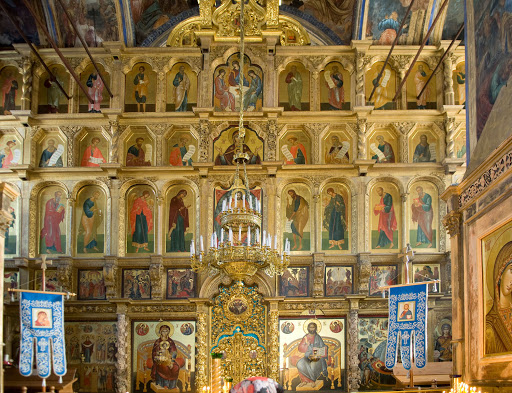 memorials, and over the centuries the Iconostasis kept getting higher and higher – and now behold!
memorials, and over the centuries the Iconostasis kept getting higher and higher – and now behold!
Dormition Cathedral, St Tikhin Monastery, Russia
Lately some Icon Screens are being constructed so that people can see through them into the Altar, so that not only will the icons show us who is in Heaven, but worshipers will feel themselves part of what is happening there. Personally, I think that’s good, so long as the Screens are constructed carefully, so people won’t be distracted by young acolytes wiggling!
Now, some peculiar things in the Divine Liturgy.
2 Why does the priest pray with his back to the people?
This one is easy. Who is the Priest offering the Holy Sacrifice to the Father at Divine Liturgy? Jesus Christ, the one True High Priest. Who else is making the Offering? We all are. God has made us “a chosen people, a royal priesthood”. I Peter 2:9 We offer ourselves and all the world in Christ to the Father, “on behalf of all and for all”. The work of the bishop or priest (accurately translated “presbyter”/ πρεσβύτερος, “elder”) is to stand at the Altar with all Christ’s priestly people, uniting ourselves with His Great Offering to the Father. For a long while, when I was Episcopalian, I followed the current Western practice for the priest to pray facing the people – till one Sunday I thought to myself “What ever am I doing back here? I’m not God the Father.” So I stopped doing that.
3 Why is the Anaphora often said silently?
The Anaphora / ἀναφορά (the “offering”) is the offering and blessing of the Holy Gifts – usually considered to begin with the Great Entrance and concluding with the Our Father.
In the early Church the Anaphora was said aloud, since these are the Peoples’ Prayers. The priest at the altar alone says the words of the Anaphora, lest there be a jumble of muttering.
Now, because of the “rise of the Iconostasis”, it was easy for people to think that the priest inside there was doing all the work. And over time many priests in the Altar began to think the same thing – that they were reciting the Anaphora for the people. Things never went as 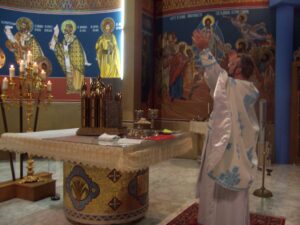 far with us as they did with the Roman Catholics, where for a long time people actually could pay money to priests to “say Masses” for them. But we Orthodox were certainly headed in the wrong direction.
far with us as they did with the Roman Catholics, where for a long time people actually could pay money to priests to “say Masses” for them. But we Orthodox were certainly headed in the wrong direction.
St Joseph’s Ukrainian Church,Chicago – from Wikimedia
And then, apparently to speed things along, priests began to hurry through the Anaphora, then to “mutter” the words, and finally just read them silently. By the Sixth Century this had become so common.that the Emperor Justinian decided to put at stop to it: “Moreover we order all bishops and priests to say the prayers used in the Divine Oblation and in Holy Baptism not inaudibly, but in a voice that can be heard by the faithful people, that the minds of those who listen may be excited to greater compunction.” Novella 137, AD 565 (Note: This assumed a language people could understand.) How did that work out? The clergy ignored him, and there we still are today, almost 1500 years later.
In recent times there has been a move to say the Anaphora aloud, restoring it to the people. We did this from the beginning at Saint NIcholas, Cedarburg. Thus far nobody has died from it. In fact many “cradle Orthodox” have said that they never before had appreciated the beauty and meaning in the Anaphora. While I’ve been shut-in during the Pandemic and, well, uh, “church hopping” livestream, I see that many bishops and priests are now saying at least parts of the Anaphora aloud.
Brothers and sisters, if the Anaphora is still said silently in your church, please don’t bug your priest about it – unless you’re pretty sure he’s wants to and could use some support. If anything in Orthodoxy has been done for generations, it’s very hard to change it. * That’s his business. He may someday do it, or maybe his successor will. Meanwhile, get yourself a copy of the Divine Liturgy and read the Anaphora silently along with him, and do your work as part of Christ’s “holy priesthood”.
- For the three of you who haven’t heard this yet: “Q. “How many Orthodox does it take to change a light bulb?” A. “CHANGE……..??!!”
4 This seems very peculiar. Why does the priest wave the Aer (the chalice veil) over the chalice during the Creed? You may have to watch very closely to 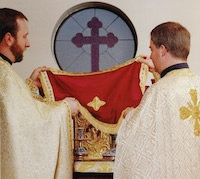 notice this – unless your priest is an enthusiastic sort. If there are two priests in your church, they both wave it between them, which is very visible.
notice this – unless your priest is an enthusiastic sort. If there are two priests in your church, they both wave it between them, which is very visible.
St George Greek Orthodox Cathedral, Greenville SC
I read that it symbolizes the coming of the Holy Spirit. If that’s so, then why isn’t it waved over the chalice during the Epiclesis – the calling down of the Holy Spirit? So what could the practical origin have been? After three decades of waving the Aer but having no idea why I was doing it, I think I have figured it out. Maybe.
Follow very closely: The wine used for the Eucharist is sweet. Sweetness tends to attract insects. Screens to keep bugs out are a modern invention, and many old world buildings still don’t have them. (Is my observation correct that insects are less numerous in Europe than here in America?) So the Holy Gifts are covered with the Veil during the early parts of the Liturgy. However, they need to be uncovered for the blessing of the Holy Gifts, beginning soon after the Great Entrance.
Now, the Creed was a late addition, inserted in the Fourth Century soon after the Great Entrance. And here comes the Orthodox approach again: “We can’t change. We must remove the Aer when we always have. But that leaves the chalice uncovered during the Creed! What ever are we to do to keep the bugs away?” Solution: “We’ll wave the Aer over it during the Creed!” That’s my theory. Aren’t you glad you asked?
Next question: So why at Hierarchical Liturgy is the Aer waved over the Bishop’s head? Don’t ask. (Does anybody here know?)
5 Why does the priest pour hot water into the chalice just before people receive Communion?
It’s called “Zeon / ζέον, “fervor”}. The answer? I have no idea. This is done only in our Byzantine rite, no others. Now, in the ancient world wine was normally “cut” with water before drinking it, as Christ surely did at His Last Supper. All traditional Christian Eucharistic rites require that. But we Orthodox already cut the Wine with water during the Proskimidi, the preparation rite before Divine Liturgy. So why now again with hot water? As he pours it, the priest says “The fervor of faith, full of the Holy Spirit”, which doesn’t explain much, because the calling down of the Holy Spirit has already taken place. Some say hot water is to remind us of the warmth of Christ’s Blood. But if that’s so, why then don’t we also warm up the Bread? I give up. But would I want to change it? Of course not. I’m Orthodox!
6 Why do we Orthodox (alone among Christian Eucharistic rites) receive the Holy Eucharist on a spoon? To explain to non-Orthodox readers: The Holy Bread is first added to the Chalice, then they are mixed, and both are administered together directly into the mouth on the spoon, which is shared by all.
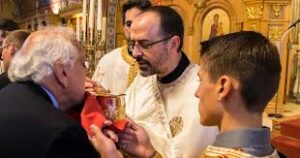
Above: St Demetrios Greek Orthodox Church, Tucson AZ
This was a very late development by Orthodox standards – 10th or 11th centuries. Till then Orthodox received Bread and Wine separately. Why the change? Nobody really knows. Concern about germs? But nobody knew about germs then, or even how diseases spread. Was it to save time? Not likely. People received the Eucharist infrequently in those days, except at Pascha. We don’t know.
Years ago, as much as I desired to become Orthodox, when I saw how Communion is received I worried: Am I going to catch everybody’s diseases? Later as a priest, I always “cleansed” the chalice using the spoon after everybody else had received from it, though I did ask people with symptoms of the flu not to receive, out of charity toward others – including me. I think I caught no more diseases diseases than anybody else. Why? The healing power of the Holy Gifts? Divine protection? I don’t know.
Most Orthodox hierarchs have directed that during the Pandemic, though people are to wear masks and keep distance in church, all should receive the Eucharist in the usual way. My reaction, if anybody cares, is …. …. For myself, I am 82 years old and have an apparent auto-immune disorder, so I have decided not receive the Eucharist till the Pandemic passes. I worship livestream every Sunday morning and, when it comes time to receive Holy Communion, I pray our Lord Jesus to forgive my sins and fill me with His strength and wisdom and healing power. I believe our God is not limited to bread and wine. When the Pandemic is over, I will receive the Holy Eucharist again with great joy. I long for it.
7 Does anyone have any more questions? Comment below, and I’ll try to answer.
Next Week, December 25: JESUS
Week after Next: Astrologers from the East
Dear Father Bill,
I feel the pandemic has forced a change in our services. Perhaps I’m a rouge Orthodox (I’m 72) but we’ve had pandemics in modern times: 1958 and 1968. Both flus caused a great deal of death and suffering but yet we continued to use a common spoon and cloth. Various bishops have instituted different ways to administer the Eucharist with even our Archbishop wanting to use separate spoons for all. This is a “change” and one that impacts the most important part of the Orthodox liturgy. I feel Christ’s Body and Blood out trumps any virus be it flu, aides and other communicable disease.
Please forgive me. I’m one of those passionate cradle Greek Orthodox parishioners.
Mike, thanks for your response. You do not need to be “forgiven”!
I’m speaking here as a new Orthodox. I was chrismated 31 years ago, so you’re 41 years “up” on me. However, here’s my reading. In Orthodoxy there is the Tradition (matters which cannot be changed) and traditions (various matters which may change from time to time). The precise border between them is a bit “fuzzy”, where there is room for debate. Since for half of Orthodox history, our people did not receive the Eucharist by spoon, I’d consider that one of the traditions. In light of modern knowledge about disease, I wish our bishops would always allow separate spoons for people who have communicable diseases of whatever sort – if only so they and others can fix their minds on our Lord Jesus Christ in the Eucharist, instead of worrying about getting sick. That’s only my opinion. However, in my Archdiocese, this is not permitted, and that is why I am not receiving Holy Communion right now.
Thank you, for this good information, Father Bill. Re your unanswered questions, have you consulted your bishop?
Thanks, again, as we look forward to your next post. BTW, may you have a blessed Nativity. In Christ,
John
Dear John:
And a blessed Nativity to you, too.
I won’t ask our Bishop Anthony now, however. He is burdened with so many things right now. Maybe then when the world settles down.
Fr Bill
Dear fr. Bill,
Greetings from Bulgaria. Thank you for this wonderful blog.
In relation to Question 4: In this old Textbook on Orthodox Liturgy (1950) at § 35 the movement of the Aer is explained as a reference to Genesis 1:2 “he Spirit of God was hovering over the face of the water” and also as a reference to Mattew 28:2 “And behold, there was a great earthquake;for an angel of the Lord descended from heaven, and came and rolled back the stone from thedoor,a and sat on it”.
http://www.pravoslavieto.com/books/liturgika_arhim_Jona/index.htm
I hope this makes sense.
Wishing you wondeful holidays,
Valery
A reader in Bulgaria! Thank you for writing, Valery.
Your comment makes sense, as does the reference from Genesis since the Epiklesis will follow in due time. I’m afraid I don’t understand the earthquake reference at this point in the Liturgy. However I still think the “action” was established first, and the symbolic explanations developed later.
A blessed Nativity to you as well. May God bless you and protect you.
Father Bill
Orthodox Christianity was not persecuted in the ancient Ethiopian Empire. We think about the Roman Empire so much that we never learn about the other areas of the early Church.
Thank you for the reminder, Thane. Persecution of Christians in Ethiopia had to wait till the Yodit Gudit era in 980, the Ahmad ibn Ibrahim al-Ghazi invasion of Ethiopian Empire during the Ethiopian-Adal War (1529–1542), the Italian occupation of Ethiopia (1936–1941), and more recently under the Communists. [Did I know all that? Of course not! I had to look it up.